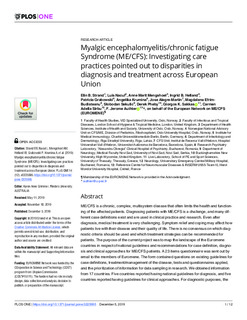| dc.description.abstract | ME/CFS is a chronic, complex, multisystem disease that often limits the health and functioning of the affected patients. Diagnosing patients with ME/CFS is a challenge, and many different case definitions exist and are used in clinical practice and research. Even after diagnosis, medical treatment is very challenging. Symptom relief and coping may affect how patients live with their disease and their quality of life. There is no consensus on which diagnostic criteria should be used and which treatment strategies can be recommended for patients. The purpose of the current project was to map the landscape of the Euromene countries in respect of national guidelines and recommendations for case definition, diagnosis and clinical approaches for ME/CFS patients. A 23 items questionnaire was sent out by email to the members of Euromene. The form contained questions on existing guidelines for case definitions, treatment/management of the disease, tests and questionnaires applied, and the prioritization of information for data sampling in research. We obtained information from 17 countries. Five countries reported having national guidelines for diagnosis, and five countries reported having guidelines for clinical approaches. For diagnostic purposes, the Fukuda criteria were most often recommended, and also the Canadian Consensus criteria, the International Consensus Criteria and the Oxford criteria were used. A mix of diagnostic criteria was applied within those countries having no guidelines. Many different questionnaires and tests were used for symptom registration and diagnostic investigation. For symptom relief, pain and anti-depressive medication were most often recommended. Cognitive Behavioral Therapy and Graded Exercise treatment were often recommended as disease management and rehabilitative/palliative strategies. The lack of consistency in recommendations across European countries urges the development of regulations, guidance and standards. The results of this study will contribute to the harmonization of diagnostic criteria and treatment for ME/CFS in Europe. | nb_NO |
